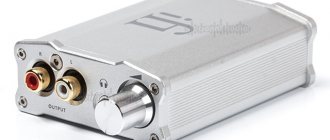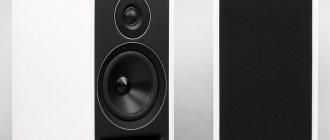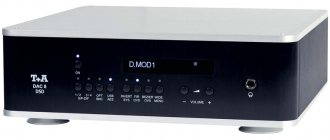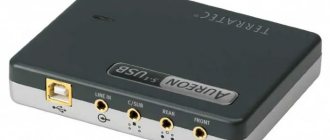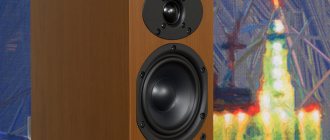Audiolab M-Dac Minimal Phase Test Report
General test results
General test results for Audiolab M-Dac Minimal Phase
Channel
general*
Frequency response unevenness in the range 40 Hz 15 kHz, dB
-0,08, +0,02
Output impedance average in the range 40 Hz 15 kHz, Ohm
0,2
Maximum output voltage level, V (rms)
3,04
Maximum output voltage level, dBV
9,7
Detailed description of technical characteristics in the table »
The table shows the main, most important technical characteristics of Audiolab M-Dac Minimal Phase
Contents of the measurement report
Main results of testing the frequency response of the amplifier under resistive loads Frequency response of the amplifier under load of the dynamic type Deviation of the frequency response of the amplifier under load of the dynamic type Frequency response of the amplifier under load of the armature type (single-driver) Deviation of the frequency response armature-type amplifier under load (single-driver) Levels of harmonic distortion under load depending on the voltage level at the output of the amplifier Noise spectrum Harmonic distortion spectrum Dynamic range spectrum (-60 dBFS) Low amplitude signal distortion spectrum -90 dBFS SMPTE intermodulation distortion spectrum CCIF intermodulation distortion spectrum Jitter test spectrum J-TEST Jitter test spectrum J-TEST
Audiolab M-DAC - Filter to taste
Audiolab's M-DAC digital-to-analog converter has more options than columns in a Sunday newspaper. And listening to him is more pleasant than reading a newspaper - at least that’s what John Miles says.
Lately I haven't been left with the persistent feeling that new DACs are being born almost every day. Am I exaggerating, you say? If so, then very little. Why should we be surprised if today more and more audiophiles download music from the Internet and listen to it from their computer? The tendency, however... In such conditions, the ability to separate the wheat from the chaff becomes especially relevant; and the new DAC from Audiolab deserves your closest attention. In recent years, Audiolab has earned a good reputation for its digital components - and, to its credit, this was primarily due to the influence of developer John Westlake, creator of the notorious DacMagic. Many still remember the excitement that accompanied the appearance of this DAC.
To say that M-DAC has many functions and settings is to say nothing. The DAC can accept signals with resolutions up to 24bit/192kHz; the user has the opportunity to choose any of seven digital filters to his taste; The DAC is equipped with a screen that displays any information you want, as well as a full range of inputs of different types, adjustable output, which makes it possible to use the DAC also as a pre-amplifier. Oh yes - I almost forgot! - It also has a remote control. Given the complexity of the device, I recommend that you read the user manual before turning it on. Taking the device out of the box, one cannot help but notice its decent weight - 4.95 kg. The front panel is dominated by a large round knob in the center, on one side of which there is a screen, and on the other - buttons for menu control, input and filter selection, a power on/off button and a headphone jack (which, by the way, has its own circuitry on discrete components ).
The rear panel contains both balanced and regular stereo output connectors, a USB 2.0 input, two optical and two coaxial inputs. There are also optical and coaxial S/PDIF outputs, in case anyone needs them. Inside you can see a high-quality ESS Saber32 9018 chip, which converts digital signals into analogue, circuits based on discrete transistors, as well as “not sickly” power filtering circuits. According to Audiolab, special attention has been paid to reducing jitter to ensure that the signal from any source reaches the digital-to-analog conversion chip in optimal form. Power comes from a hefty external power supply; The device is also equipped with a small, but nevertheless fully functional remote control. Setting up the M-DAC for use with a Mac and iPad turned out to be relatively simple and hassle-free (OS 10.4.11 or higher is recommended). PCs will require their own drivers; The user manual devotes as many as nine pages to the installation procedure. Once turned on and connected to the computer, controlling the DAC was a piece of cake. All settings are accessible from the remote control, and the front panel screen displays a ton of useful information, including the nominal or exact bitrate of the incoming signal - which, among other things, allows you to make sure that you are receiving an accurate high-resolution signal. You can even see information from the CD about the track and its duration on the screen.
As noted above, this DAC can be connected directly to a power amplifier. Admittedly, the idea of getting rid of an extra link (and component) in a signal chain may seem tempting to some. In this case, the volume knob also allows you to adjust the balance. If the DAC is connected to a pre-amplifier, then volume and balance controls can be disabled.
SOUND QUALITY
With so many filters and settings available, it can be difficult to know where to start listening. Therefore, without further ado, I decided to follow the advice of Audiolab itself and chose filters from the Optimal Transient group to begin with. The manufacturer claims that they technically provide the most natural and clear sound. Having connected the DAC to the MacBook Pro and listened to several files with a resolution of 24/96 kHz and higher, I came to the conclusion that, despite all its technical complexity, the M-DAC sounds confident and at the same time extremely melodic. The amplitude-frequency range pleased with its length at both ends; the bass was distinguished by density and confident presentation, but without the slightest signs of its dominance over other areas of the frequency response; the treble was pleasant to the ear and sounded open. The sound detail was also exceptional. The Vince Guaraldi Trio's "A Charlie Brown Christmas" in 24/192 from HDtracks allowed the M-DAC to demonstrate its impressive capabilities. The Guaraldi piano sounded dynamic and very spacious, and the children's choir sounded so incredibly clear that it was easy to distinguish individual voices.
Switching between the three filter options in the Optimal Transient group resulted in slight changes in the sound—though the difference wasn't night and day. Overall, the sound with these filters can be described as pleasant, a little dark, but still rich in detail. But when I tried the remaining four filters (Sharp Rolloff, Slow Rolloff, Minimum Phase and Optimal Spectrum) while listening to the same Vince Guaraldi Trio tracks, that's when I noticed quite a significant difference in sound. In particular, the Optimal Spectrum filter sounded sharper and more transparent, but at the same time more fatiguing after prolonged listening, while the Slow Rolloff filter made the sound less crystal clear, but smoother and more analogue-like. What’s interesting is that the transition from high-resolution files to regular “good old” CDs further revealed the difference in the sound of different filters.
The difference between high-bitrate music files and regular CDs was most obvious when choosing the Spectrum filter. But, nevertheless, even with this filter, the DAC played the CD so well, rhythmically true and confidently, that it is unlikely that any other DAC in the same price niche (£600) can compare with it. I also noted that the Optimal Transient filter made the CD sound noticeably thicker and richer. This is where the beauty of being able to choose different filters lies. For example, the Minimum Phase filter added more body and tangibility to Keith Jarrett's solo piano on his "Koln Concert". And the Optimal Transient filter was perfect for Nick Cave's dark and rough growling vocals on his despairing track "The Curse Of Millhaven". In the end, the choice of filter will depend largely on recording quality and personal preference - which is what makes the M-DAC such an excellent audio component. Having dealt with the different filter options, one cannot help but notice that, in fact, Audiolab is a very musical device. There is a certain amazing coherence to its sound that is simply mesmerizing, and which you rarely see in other DACs. One of the M-DAC's best qualities is its ability to unravel complex areas of a piece of music without becoming overly pedantic and analytical, or losing the feel of the music as a whole. Thus, by reproducing the dense cacophony of sounds in John Coltrane's "Ascension", the M-DAC allowed me to hear individual performers and each of them's individual contributions to the overall complex fabric of the musical work. Switching to Tim Hagans' "Asiento", Audiolab introduced me to the trumpet player's technical prowess, allowing me to enjoy his effortless and virtuoso control of the instrument in the upper registers. Resolution remains remarkably flat across the entire frequency range, meaning the M-DAC excels at reproducing fast tonal and dynamic contrasts. The Pixies' "Debaser" starts off with some really heavy bass, but later, as the guitars kick in, Audiolab switches gears with ease, matching the changing tempo of the music on the fly. Despite the plethora of musical information, the sound remains precise and controlled.
Not once did I get the impression that the M-DAC was faced with music that was too complex for it to handle. Even pop music with a high degree of processing was reproduced by the DAC quite skillfully - despite the small dynamic range of pop music, even it sounded like you wanted to listen to it and listen to it. What I also liked about the M-DAC is its ability to please the listener in any mood: when you want to relax, sit back and “just listen” to the music; and when you listen to music with concentration and attention, paying attention to individual elements in the overall sound. By the way, most of the time I tested the Audiolab M-DAC in the mode of fixed audio output volume, the signal from which was fed to the Naim preamplifier. However, activating the volume control on the DAC and connecting it directly to the power amplifier showed that the M-DAC is capable of sounding well in this mode. The volume control is perfectly balanced, the DAC retains its rhythmic drive and, in general, sound detail. The sound may have become a little less intelligible at low volumes - but not so much that this M-DAC cannot be recommended for creating a system where the DAC is connected directly to a good power amplifier.
CONCLUSION
The Audiolab M-DAC has made such a positive impression on me that I don't even know where to start. First of all, its strong point is, of course, a huge number of settings. The ability to select a filter helps to “select” the desired tone of sound for different recordings and their formats. Once you play with them a little, you'll quickly realize how handy they are—even if you end up sticking with just one filter for most of your music. But all of this would be for naught if, at its very heart, Audiolab was not a very, very good sounding DAC. And he, without any doubt, sounds great. To put it simply, he manages to get the best from every digital source - be it CD, streaming or computer files. The DAC is also worthy of all praise for its excellent sound detail, excellent dynamics and vigorous presentation of musical material, as well as its accurate and skillful handling of any, even the most complex recordings. Very correct bass - deep but harmonious, and the upper registers are clear and soft. Considering the ease of use, the fully functional remote control that allows you to control the unit from the comfort of your favorite chair or sofa, and the digital volume control that eliminates the need for a separate preamplifier, Audiolab has truly offered audiophiles a very attractive device. As noted at the beginning of this review, there is currently no shortage of external DACs on the market - but the M-DAC can rightfully be considered one of the best in its class - especially considering its price. My best recommendations.
MEASURED TECHNICAL CHARACTERISTICS
Measurements confirm that the Audiolab M-DAC has a flat amplitude-frequency response in the range from 4 Hz to 72 kHz (-1 dB) with a signal frequency of 192 kHz at its widest range with the Minimum Phase filter. This only applies to the coaxial digital input S/PDIF, because optical input accepts signals with a maximum frequency of 96 kHz; it cannot receive signals with a frequency of either 176.4 kHz or 192 kHz - due to limitations of the optical signal receiver itself. The seven filters are divided into categories and, interestingly, I liked the ones that Audiolab chose as optimal. Slow filters cut off the high frequencies more than others, but they are free from such an undesirable phenomenon as pre-ringing (“pre-echo”); These filters can be said to sound “dark” or “dim.” These filters are combined into one group called Optimal Transient - and there are three such groups in total. In addition, there are Sharp, Minimal Phase and Optimal filters, all of which have the widest application because they do not cut off the high frequencies so dear to our hearts. However, already on a 96 kHz signal the frequency range remains untouched. The situation with signals from CD and 48 kHz is different - on these signals Optimal filters add “warmth” to the sound. With such signals, the Slow filters will most likely make the sound darkest, but with the Sharp Rolloff and Optimal Spectrum filters the CD will sound normal. Distortion at 0 dB turned out to be extremely small - only 0.002%. At -60 dB the result was 0.013% with a 24 bit XLR output at full gain (lowest noise). This is a very good indicator and only the best devices can boast of it. Interestingly, the distortion on the 16-bit signal turned out to be quite high - 0.27%. This discrepancy affected the EIAJ dynamic range values, which for CD (16 bit) turned out to be a measly 98 dB, but at 24 bit the result was no lower than 124 dB - which is a new record, and it is even higher than that of the Teac UD-DAC. 501. But, unlike Teac, the distortion level of M-DAC does not depend on the selected filter. Measurements showed that the maximum voltage on the unbalanced output is 3.2V, and on the XLR - 6.5V. Apart from this, no differences were found between them. Audiolab M-DAC has a number of interesting filter settings that, subjectively, affect the sound more than other settings - allowing the listener to literally “tailor” the sound to their taste. The distortion on the CD format signal turned out to be high, which is disappointing - but on high-bitrate material the distortion is extremely low.
Frequency response (-1dB) CD 2Hz - 72kHz Distortion (%) 0dB 0.002 -60dB 0.013 Channel separation (1kHz) 121dB Noise (IEC A) -123dB Dynamic range 124dB Output voltage 2.2/4.4V
AUDIOLAB M-DAC Price: £600 VERDICT - Great sound, a wealth of features and impressive customization flexibility make this Audiolab DAC an outstanding component at its price point.
PROS: - great sound - large selection of filters - full-featured remote control - can be used as a digital preamp
CONS: - nothing for this price
Based on materials from Hi-Fi World
Audiolab M-DAC nano - test in “What Hi-Fi? Sound & Vision"
In the British magazine “What Hi-Fi? Sound & Vision" (May 24, 2019), published a test of the Audiolab M-DAC nano USB DAC/headphone amplifier. The author of the article concluded that "We have yet to come across a portable DAC that is better than this one." He gave it the highest score for sound - 5, for functional equipment - 4, for workmanship - 4, and as a result, the overall maximum rating - 5 stars!
VERDICT
A great way to improve the sound quality from your smartphone or laptop. We can't think of a better alternative for portable use.
PROS : elasticity of bass and sophistication of sound, compactness and light weight, wireless operation
“If you want to improve the sound quality from your smartphone or laptop, there aren't many options. Until now, our recommendations would have been limited to adding a portable USB DAC such as the Audioquest Dragonfly Red. It's a great device and does the job brilliantly for the money, but it's not ideal for truly portable use. It requires an extra cable to work with your smartphone, meaning you have to carry around a rather bulky combination of smartphone, adapter cable and DAC. It's quite difficult to fit all of this into one pocket, no matter how small the DAC itself is. But Audiolab offers a tempting alternative with the new M-DAC nano.”
“The M-DAC nano is a tiny device, barely larger than a custard cookie, and weighs just 28 grams. Compactness and light weight are important for portability, but the nano's biggest advantage over its competitors is that it connects to your smartphone wirelessly, in this case via apt X Bluetooth (v4.2).”
“If we had any doubts about the nano's performance, we thought about the impact of Bluetooth on sound quality. For its price, it should offer a significant improvement in sound compared to connecting the headphones directly to your smartphone. Bluetooth, even its apt X codec, can make this goal somewhat difficult to achieve.”
“In testing, we used the M-DAC nano with our iPhone 6s Plus and with a Macbook. It didn't take long to realize that the nano provided a noticeable improvement in sound for both devices. We tried a range of headphones - from AKG's Y50S and Sennheiser Momentum 2.0 s to Beyerdynamics' T1s - because... nano supports 8-300 ohm loads. The T1s in particular weren't an obvious match, being overly expensive, but they bring out the nuances of recordings incredibly well, not to mention their low sensitivity puts a serious strain on Audiolab."
“We listened to alt-J's 'All This Is Yours' and were very impressed by the solidity of the sound and the noticeable improvement in bass punch and power compared to our sources. Not only does the nano make our headphones sound louder, it also adds a noticeable degree of sonic refinement. Detail levels are also good, with Audiolab maintaining tight control over the various instrument parts throughout the density of the recordings on this album.”
“We switch to “The Rite Of Spring” by Stravinsky, and “nano” responds to us with wide dynamics and a pleasant dose of rhythmic drive. Tonally, things are nicely balanced, without any undue emphasis on particular parts of the frequency range."
“Overall this is an exciting and entertaining performance that is quite comparable to what we heard from Audioquest Dragonfly Red. But here it’s a definite compliment, considering that the Dragonfly connects to your device with a cable, and the Audiolab does not.”
VERDICT
If you have a good pair of wired headphones and want to improve your sound quality on the move, then the Audiolab M-DAC nano is an excellent choice. We can't find any alternative to the nano at a similar price that would be as convenient and at the same time as effective.
We recommend looking at the following models:
- AudioLab M-DAC nano headphone amplifier.
Audiolab M-DAC mini battery-powered DAC
Audiolab M-DAC mini
blurs the boundaries between home hi-fi DACs and their pocket brethren.
It's the perfect size to sit discreetly on your desk, plus easy-to-use controls and a traditional analog volume control. There's enough internal space to allow key circuitry to be implemented on discrete audiophile components, avoiding many of the compromises often inherent in portable DAC designs. The compact form factor makes the M-DAC mini easy to carry and self-contained (not tied to a power outlet) thanks to its built-in rechargeable battery. Like the M-DAC+
, the M-DAC Mini DAC can accept and process up to 32-bit/384 kHz PCM audio data
from
a
USB input
,
ensuring compatibility with today's and future high-resolution music formats.
The USB input also supports DSD64, DSD128 and DSD256
streams - a significant addition as DSD plays an important role in the development of high-definition downloading today.
Sound quality is of paramount importance to all Audiolab M-DAC mini circuitry. For example, while most portable DACs use digital volume controls, which reduce sound quality, the M-DAC Mini uses a high-quality analog potentiometer, like those often found on full-size stereo components.
M-DAC Mini, like the previously released M-DAC and M-DAC+, combines advanced digital-to-analog conversion techniques with high-quality sound - thanks to a Class A
, implemented on
JFET transistors
, and a separate headphone amplifier section. It provides excellent sound quality, whether connected to an amplifier and speakers, or to a pair of active speakers, or to headphones. This is the first time battery power has been used in a DAC for reasons other than portability. It also benefits in sound quality - thanks to clean, stable DC power - free from the distortion inherent in switching power supplies, and without bulky and expensive audiophile power supplies. A charger is included, and when connected to mains power, all iOS and Android devices can be charged directly from the M-DAC Mini.
Main technical characteristics of the Audiolab M-DAC mini DAC:
DAC:
ESS Saber32 Reference ES9018K2M
Sampling rates:
24 bit / 192 kHz (Optical, Coaxial), 32 bit / 384 kHz (USB), 2.8MHz (DSD64), 5.6MHz (DSD128), 11.2MHz (DSD256)
Digital inputs:
Coaxial, Optical, USB micro-B for PC/Android, USB-A for iOS, Bluetooth
Integrated amplifier with DAC and Bluetooth from Audiolab
Audiolab M-ONE
is a compact integrated amplifier, the latest addition to the M-DAC family of DACs.
Using proven DAC and proprietary amplifier technology in one small package, Audiolab M-ONE delivers immersive audio performance up to 384 kHz. It has a wide selection of input connectors, both analog and digital, and supports Bluetooth
with
aptX
.
There is also a USB
.
Audiolab M-ONE is an amplifier for modern music lovers. Externally, the M-ONE is almost identical to the flagship Audiolab M-DAC+ DAC
. It has the same aluminum body, compact enough to sit on a desk or shelf, with the same OLED display in the center and an elegant pair of adjustment knobs. However, if a stand-alone DAC also requires a separate power amplifier in the system to work with a pair of speakers, then M-ONE has a fairly high-quality stereo power amplifier inside, plus a pre-amplifier for analogue as well as digital sources.
Audiolab M-ONE DAC section
is equipped with everything you need to process PCM audio data with a resolution of up to
32 bit / 384 kHz
, coming to the USB input.
This ensures that M-ONE can take advantage of high-resolution digital sources not only now, but also in the future. DSD
digital stream (a format developed for
Super Audio CD
), offering compatibility with
DSD64
,
DSD128
and
DSD256
. To get the most out of the latest audio processing techniques, Audiolab M-ONE features several user-selectable filters to fine-tune the sound from a digital source to the owner's taste. A choice of three filters for PCM and four for DSD offers personalized sound options to compensate for differences in sound quality between different sources and digital file types.
The preamp section combines minimalist design with high-quality components, providing the shortest, most direct signal path to maintain pure sound. The volume is adjusted in the analogue part, but with digital control, outputting the signal directly to the amplifier in class AB
, which provides an output power of
40 W
per channel into 8 ohms – sufficient to drive modern speaker systems. The low-noise linear power supply, based on a shielded toroidal power transformer, is divided into multiple sections to keep crosstalk from the DAC to the power amplifier to a minimum. This no-compromise circuit design delivers an open and large-scale soundstage, filled with crisp detail and fast, crisp musical transitions. When used with speakers of the appropriate class, Audiolab M-ONE demonstrates a high sound quality that contrasts with its miniature size. In addition to the main power amplifier, Audiolab M-ONE is equipped with a high-quality headphone amplifier, the same as the M-DAC and M-DAC+, ensuring superior sound for personal listening sessions.
Main technical characteristics of Audiolab M-ONE:
Integrated amplifier with DAC and Bluetooth
Output power:
2 x 40 W at 8 ohms, 2 x 60 W at 4 ohms
Sampling rates:
32 bit / 192 kHz (Optical, Coaxial), 32 bit / 384 kHz (USB), 2.8MHz (DSD64), 5.6MHz (DSD128), 11.2MHz (DSD256)
Input sensitivity:
515 mV
Input impedance:
10 kOhm




